Why Opportunities are Plentiful in the Futures Markets
The past several months have not been kind to securities investors who subscribe to the buy-and-hold philosophy. Nor has the market rewarded investors who sought out the non-correlation of commodities to the stock market.
Investors who put money into various commodity oriented index funds and ETFs, which only hold long positions in commodity futures, have seen values plunge. If readers need a visual, just look at the wheat and crude oil daily bar charts (below) to see how dramatic the downturn has been.
This article will focus on a limited-risk trading strategy too often over-looked by traders. But first, some basic background information.
Futures Markets
The futures markets cover seven broad market segments*. Over the past four months many of these markets have experienced dramatic reversals from major bull markets into major bear markets. Others (like Gold) are showing signs of a reversing trend back to the upside) and the U.S. Dollar Index has been in a bull market since. But regardless, almost all futures contracts are exhibiting the same volatility and explosive behavior that we now see almost daily in the stock market.
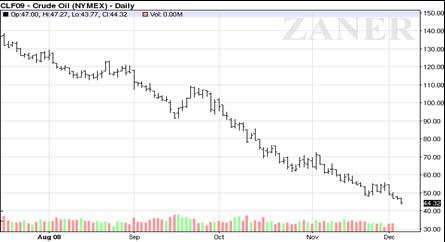
February 2009 Crude Oil futures: July 17 – December 4, 2008
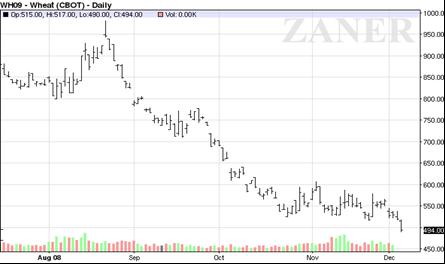
March 2009 Wheat Futures: July 17 – December 4, 2008
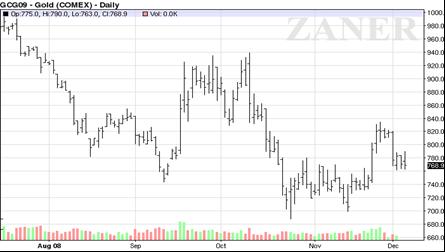
February 2009 Gold Futures: July 17 – December 4, 2008
We should remember that futures markets exist for the purpose of trading futures contracts…and futures contracts are first and foremost, forward pricing tools used by hedgers for the purpose of risk management. But futures markets openly allow and encourage public participation, euphuism for speculation. Speculative trading in futures tends to be short-term and highly leveraged. This is what gives futures contracts such incredible profit opportunities as well as high risk of loss. Because futures contracts are not assets in the sense that individual securities (i.e. stock certificates) are assets representing ownership, futures traders can actively trade from the short side. In fact, for every contract that is held long, there is a short on the other side.
Looking at the wheat and crude oil charts above, certainly there are traders who, with foresight and discipline have maintained short positions since the summer and have reaped incredible profits. But to trade these markets requires a margin deposit, more properly termed performance bond. The minimum margin requirements are set by the futures exchanges as a function of risk and volatility (not as a percentage of contract value) and not unexpectedly, these performance bond requirements have been going up regularly.
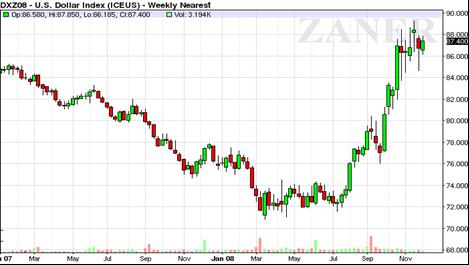
U.S. Dollar Index Futures; weekly bar chart: January 2007 – Dec 2008
Alternative Opportunities for Trading
Besides an outright long or short position in a futures contract, what other way are we seeing traders place speculative trades profitably? Options on futures, specifically, simple long call and long put positions.
Long options can allow the trader to stay in the market – to stay with the larger picture trend – but not be forced out by brief but violent price swings. More specifically, we have been focusing on out-of-money and deep-out-of-money strikes which typically will have three to six weeks until expiration.
Timing is no longer quite as important as it is with outright long and short futures positions because the option’s cost (premium + commission + exchange fee) is paid in full at the time the option (put or call) is purchased. Over the past three months it has not been unusual to see such options increase 10-fold their original purchase value. Of course, there is always risk and many such options have also expired worthless.
An Illustrative Case In Point
Gold futures fell $250.00 per troy ounce between October 10 and October 24, and then went into a congestion range.
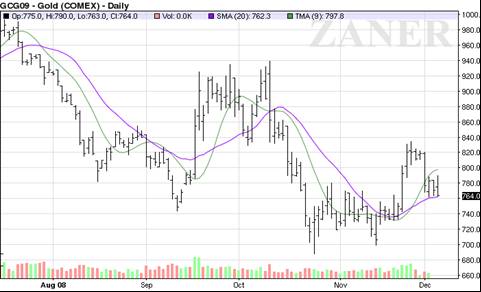
By November 16, the 9 and 18-day moving averages had converged, indicating that a new direction in the trend (up) was likely, but this was not a buy signal. The moving averages did finally cross on November 26. Whether or not this was a buy signal or further evidence of the new trend is for subjective interpretation. The cautious trader may have purchased call options rather than initiate a long futures position. This allows for a bullish consensus market position while at the same time limiting the downside risk to cost of the purchased calls.
An outright long futures position would, at this time, require constant attention, as the futures contract has had some extreme up and down price action since November 16. However, these deep-out-of-money options have gone from $2.00/ounce to $5.80**. There is always risk that these options could expire worthless but many traders focusing on the change in trend will be comfortable in managing the downside risk of $200 per option in return for potentially large percentage-based gains. And since options-on-futures are American style, traders can liquidate the position at virtually any time – there is no need to hold the option contract until the December 23, 2008 expiration date.
Conclusion
Traders looking to establish positions on perceived turn-arounds in almost any market which has an established futures contract, should consider out-of-money and deep-out-of-money call options, specifically those with a three to six week term before expiration. These positions still need to be managed, with profits taken when appropriate rather than holding until expiration. By the same token, the bears will continue to find opportunities in similar long put option positions.
Footnotes
* Metals, Energies, Stock Indices, Financial (Interest Rates), Currencies, Agricultural Commodities (including Meats, Grains, Lumber and Softs) and Economic Indices.
** The gold futures contract is based on 100 troy ounces; so with a premium of $2.00/oz, one call option would have cost $200.00 + commission and fees.
Neither the information nor any opinion expressed in this article constitutes a solicitation of the Zaner Group. Transactions in futures, options and forex carry a high degree of risk.
Larry Baer is a senior broker and analyst for Zaner Group and can be reached at lbaer@zaner.com (or toll-free-888.281.4161). Larry’s charts, commentary and trade set-ups can be seen daily on the MarketHead section of the Zaner Group website, at: https://www.zaner.com/3.0/market_information/commentary-lb.asp.
Larry Schneider is director of marketing and business development for Zaner Group, a futures and forex brokerage firm that offers platforms for self-directed traders and traditional broker-client full service for all futures markets and contracts, worldwide (www.zaner.com). Larry has spent over thirty years in the futures industry and has served on the National Futures Association’s Advisory Committee on Testing and Education since 1976.
Click here to sign up for a free, online presentation by Larry Connors, CEO and founder of TradingMarkets, as he introduces The Machine, the first and only financial software that allows traders and investors to design and build quantified portfolios.
